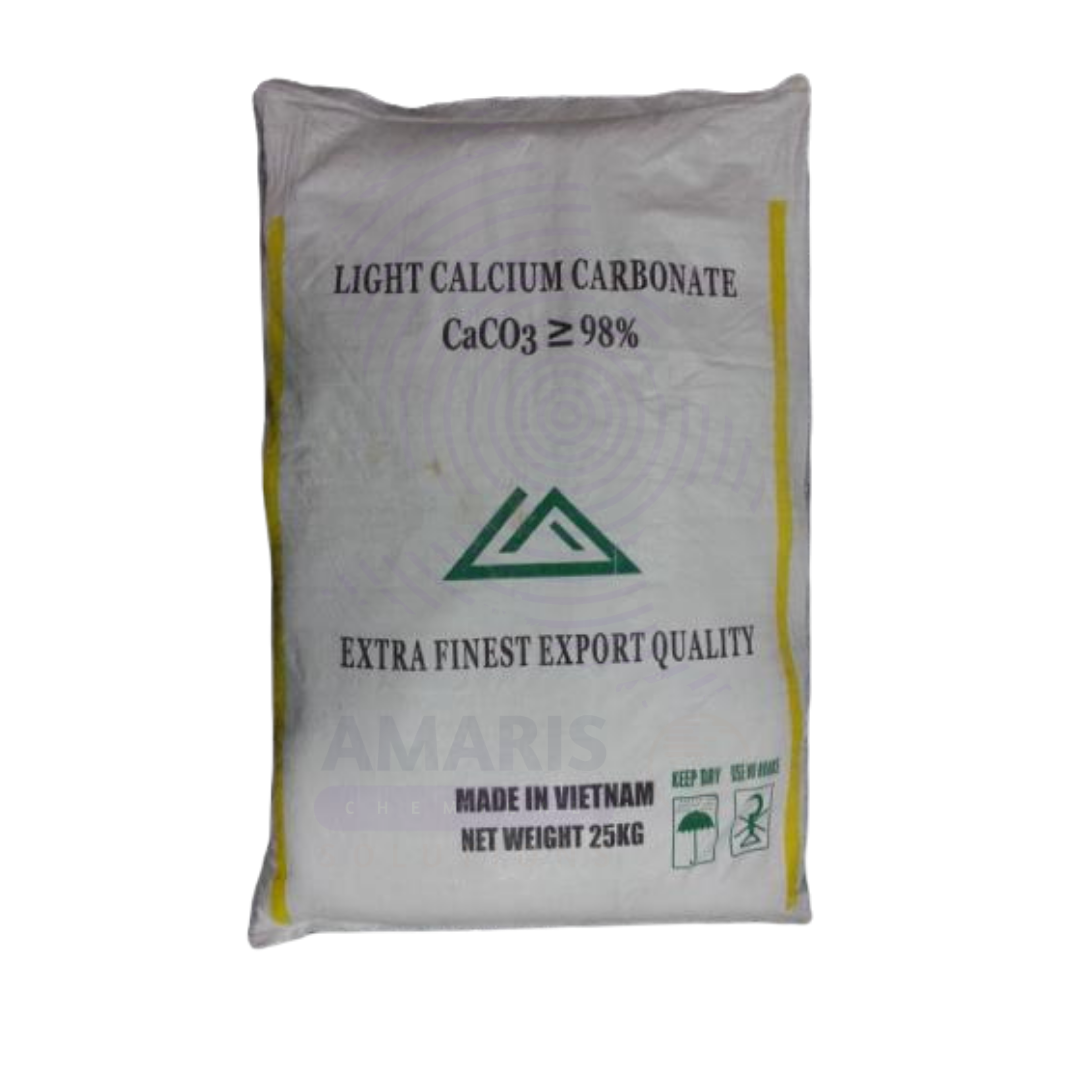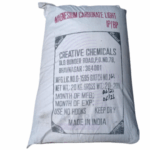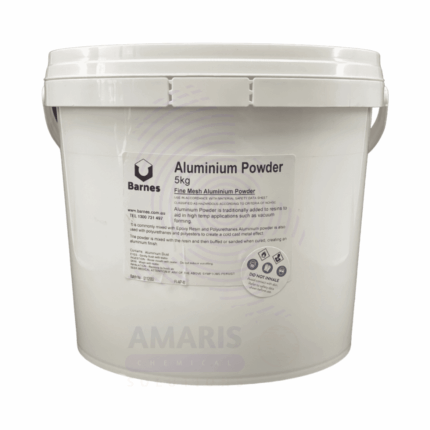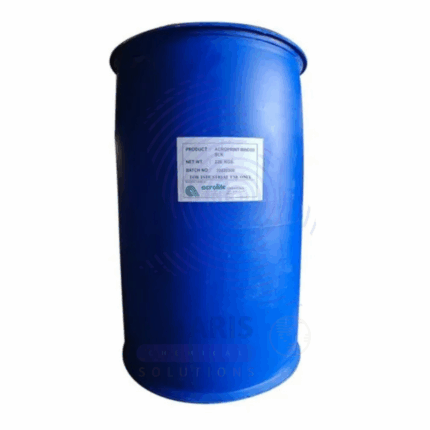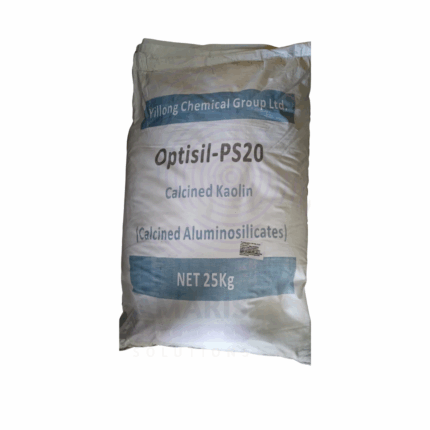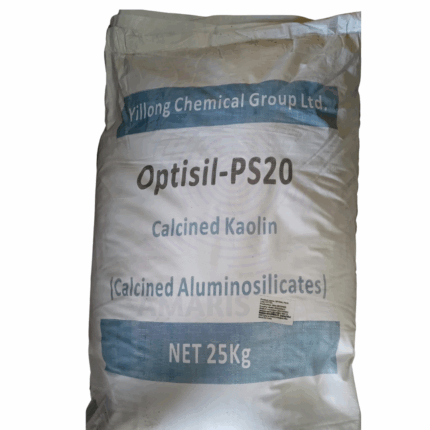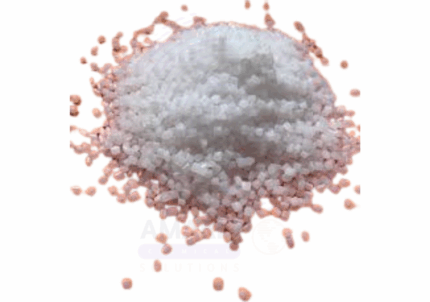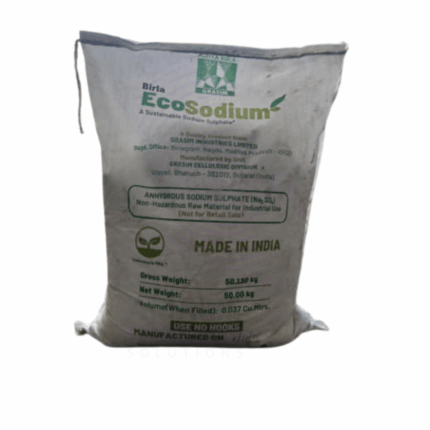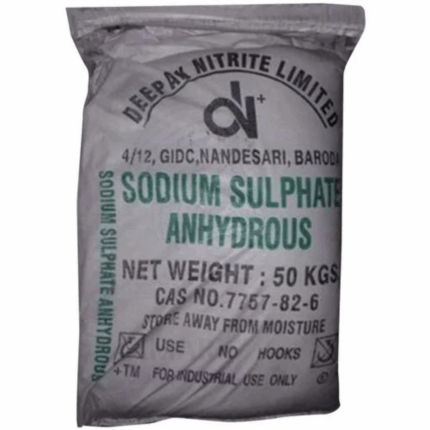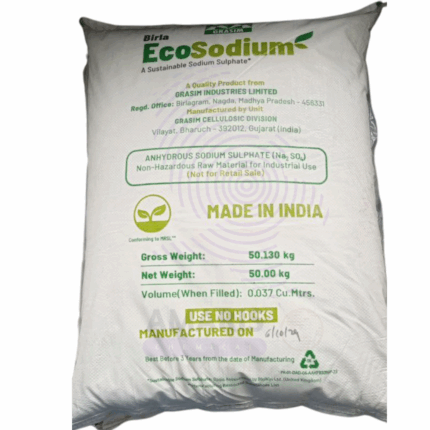Calcium Carbonate Light
$ 1.05 Original price was: $ 1.05.$ 0.93Current price is: $ 0.93.
Calcium Carbonate Light is a finely ground, low bulk density natural mineral composed primarily of calcium carbonate (CaCO₃). Compared to standard grades, it has a lower density and larger particle size distribution, making it suitable for applications where light weight and high brightness are important. This form is extensively used as a filler and extender in industries such as plastics, paints, rubber, paper, adhesives, and construction materials to improve opacity, brightness, and texture, while maintaining low weight and cost efficiency. Its chemical inertness and whiteness provide functional and aesthetic advantages across formulations.
Calcium Carbonate Light
Primary Uses
- Plastics Industry
- Used as a lightweight filler in polypropylene, polyethylene, and other polymers to reduce weight without compromising mechanical properties.
- Improves surface finish and opacity in molded and extruded plastic products.
- Reduces production costs by partially replacing expensive polymers.
- Paints and Coatings
- Functions as a pigment extender to enhance whiteness, brightness, and opacity in water-based and solvent-based paints.
- Controls rheology and improves film durability and resistance.
- Rubber Industry
- Incorporated as a filler to improve softness, whiteness, and processability of rubber products.
- Enhances tensile strength and abrasion resistance in some compounds.
- Paper Industry
- Used to increase brightness, opacity, and print quality in paper and paperboard products.
- Construction Materials
- Acts as a lightweight filler in plasters, cement, and mortar, improving texture and reducing shrinkage.
Secondary Uses
- Adhesives and Sealants
- Adds body and improves consistency in adhesive formulations.
- Cosmetics
- Used as a pigment and absorbent in powders and creams (subject to purity and regulatory compliance).
- Agriculture
- Sometimes used as a soil conditioner to modify pH and supply calcium.
1. Basic Identification Attributes
- Chemical Name (IUPAC): Calcium carbonate
- Common/Trade Name: Calcium Carbonate Light
- CAS Number: 471-34-1
- HS Code: 2836.50.00
- Molecular Formula: CaCO₃
- Synonyms:
- Light calcium carbonate
- Low bulk density calcium carbonate
- Soft calcium carbonate
2. Physical & Chemical Properties
- Physical State: Fine white powder
- Color & Odor: White; odorless
- Bulk Density: Lower than standard grades, approx. 0.5–0.8 g/cm³ (varies by supplier)
- Particle Size: Larger and less dense than heavy grades; often micron-sized or larger particles
- Specific Surface Area: Lower surface area compared to heavy grades
- Density: True density approx. 2.7–2.8 g/cm³
- Solubility: Insoluble in water; reacts with acids releasing CO₂ gas
- pH: Slightly alkaline (pH ~9 in aqueous suspension)
- Melting Point: Decomposes at ~825°C with CO₂ release
- Stability: Chemically inert and stable under standard conditions
3. Safety & Hazard Attributes
- Hazard Class (GHS): Not hazardous; nuisance dust
- NFPA Ratings:
- Health: 1
- Flammability: 0
- Reactivity: 0
- Exposure Limits: OSHA PEL: 15 mg/m³ total dust
- Toxicity: Low acute toxicity; inhalation of dust can cause mild respiratory irritation
- Reactivity: Stable; reacts with acids releasing carbon dioxide
4. Storage & Handling Attributes
- Storage Conditions: Store in a dry, cool, well-ventilated area
- Container Type: Supplied in bags or bulk containers with dust control
- Shelf Life: Indefinite when stored properly
- Special Handling: Use dust control measures and PPE to prevent inhalation
5. Regulatory & Compliance Attributes
- FDA Status: Depending on purity, may be suitable for indirect food contact and pharmaceutical use (verify regulatory status)
- Transportation: Not regulated as hazardous material
- Waste Disposal: Dispose as non-hazardous industrial waste per local laws
6. Environmental & Health Impact
- Ecotoxicity: Minimal environmental risk; naturally occurring mineral
- Persistence: Persistent in the environment; chemically inert
- Bioaccumulation: Not expected to bioaccumulate
- Carcinogenicity/Mutagenicity: Not classified as carcinogenic or mutagenic
- Biodegradability: Not biodegradable
Safety Handling Precautions
Personal Protective Equipment (PPE):
- Dust mask or respirator (NIOSH-approved)
- Gloves
- Safety goggles
- Protective clothing
Handling Measures:
- Avoid dust generation and inhalation
- Use local exhaust ventilation
- Handle in well-ventilated areas
Storage Measures:
- Keep containers sealed and dry
- Protect from moisture and acids
Hygiene Practices:
- Wash hands thoroughly after handling
- Avoid eating, drinking, or smoking during use
First Aid Measures
- Inhalation: Move to fresh air; seek medical attention if respiratory symptoms develop
- Skin Contact: Wash skin with soap and water; seek medical help if irritation occurs
- Eye Contact: Rinse eyes with plenty of water for 15 minutes; get medical advice if irritation persists
- Ingestion: Low toxicity; rinse mouth and seek medical help if large quantities ingested
Firefighting Measures
- Fire Hazards: Non-flammable
- Extinguishing Media: Water spray, foam, dry chemical, or CO₂ as appropriate
- Special Precautions: None specific
- Decomposition Products: Carbon dioxide released under extreme heat


 Preservatives(food)
Preservatives(food) Flavor Enhancers
Flavor Enhancers Acidulants
Acidulants Sweeteners
Sweeteners Antioxidants
Antioxidants Colorants(food)
Colorants(food) Nutraceutical Ingredients (food)
Nutraceutical Ingredients (food) Nutrient Supplements
Nutrient Supplements Emulsifiers
Emulsifiers
 Collectors
Collectors Dust Suppressants
Dust Suppressants Explosives and Blasting Agents
Explosives and Blasting Agents Flocculants and Coagulants
Flocculants and Coagulants Frothers
Frothers Leaching Agents
Leaching Agents pH Modifiers
pH Modifiers Precious Metal Extraction Agents
Precious Metal Extraction Agents
 Antioxidants(plastic)
Antioxidants(plastic) Colorants (Pigments, Dyes)
Colorants (Pigments, Dyes) Fillers and Reinforcements
Fillers and Reinforcements Flame Retardants
Flame Retardants Monomers
Monomers Plasticizers
Plasticizers Polymerization Initiators
Polymerization Initiators Stabilizers (UV, Heat)
Stabilizers (UV, Heat)
 Antifoaming Agents
Antifoaming Agents Chelating Agents
Chelating Agents Coagulants and Flocculants
Coagulants and Flocculants Corrosion Inhibitors
Corrosion Inhibitors Disinfectants and Biocides
Disinfectants and Biocides Oxidizing Agents
Oxidizing Agents pH Adjusters
pH Adjusters Scale Inhibitors( water)
Scale Inhibitors( water)
 Antioxidants(cosmetic)
Antioxidants(cosmetic) Emollients
Emollients Fragrances and Essential Oils
Fragrances and Essential Oils Humectants
Humectants Preservatives
Preservatives Surfactants(cosmetic)
Surfactants(cosmetic) Thickeners
Thickeners UV Filters
UV Filters
 Fertilizers
Fertilizers Soil Conditioners
Soil Conditioners Plant Growth Regulators
Plant Growth Regulators Animal Feed Additives
Animal Feed Additives Biostimulants
Biostimulants Pesticides (Herbicides, Insecticides, Fungicides)
Pesticides (Herbicides, Insecticides, Fungicides)
 Active Pharmaceutical Ingredients (APIs)
Active Pharmaceutical Ingredients (APIs) Excipients
Excipients Solvents(pharmaceutical)
Solvents(pharmaceutical) Antibiotics
Antibiotics Antiseptics and Disinfectants
Antiseptics and Disinfectants Vaccine Adjuvants
Vaccine Adjuvants Nutraceutical Ingredients (pharmaceutical)
Nutraceutical Ingredients (pharmaceutical) Analgesics & Antipyretics
Analgesics & Antipyretics
 Analytical Reagents
Analytical Reagents Solvents(lab)
Solvents(lab) Chromatography Chemicals
Chromatography Chemicals Spectroscopy Reagents
Spectroscopy Reagents microbiology-and-cell-culture-reagents
microbiology-and-cell-culture-reagents Molecular Biology Reagents
Molecular Biology Reagents Biochemical Reagents
Biochemical Reagents Inorganic and Organic Standards
Inorganic and Organic Standards Laboratory Safety Chemicals
Laboratory Safety Chemicals Specialty Laboratory Chemicals(Special Laboratory Equipment)
Specialty Laboratory Chemicals(Special Laboratory Equipment)
 Demulsifiers
Demulsifiers Hydraulic Fracturing Fluids
Hydraulic Fracturing Fluids Scale Inhibitors(oil)
Scale Inhibitors(oil) Surfactants(oil)
Surfactants(oil) Drilling Fluids
Drilling Fluids
 Dyes and Pigments
Dyes and Pigments Bleaching Agents
Bleaching Agents Softening Agents
Softening Agents Finishing Agents
Finishing Agents Antistatic Agents
Antistatic Agents
 Admixtures
Admixtures Waterproofing Agents
Waterproofing Agents Sealants and Adhesives
Sealants and Adhesives Curing Compounds
Curing Compounds Concrete Repair Chemicals
Concrete Repair Chemicals Anti-Corrosion Coatings
Anti-Corrosion Coatings
 Surfactants(cleaning)
Surfactants(cleaning) Builders
Builders Enzymes
Enzymes Solvents (Cleaning)
Solvents (Cleaning) Fragrances
Fragrances
 Electronic Chemicals
Electronic Chemicals Catalysts
Catalysts Lubricants
Lubricants Photographic Chemicals
Photographic Chemicals Refrigerants
Refrigerants Automotive chemicals
Automotive chemicals Pyrotechnic Chemicals
Pyrotechnic Chemicals
 Biodegradable Surfactants
Biodegradable Surfactants Bio-based Solvents
Bio-based Solvents Renewable Polymers
Renewable Polymers Carbon Capture Chemicals
Carbon Capture Chemicals Wastewater Treatment Chemicals
Wastewater Treatment Chemicals
 Pigments
Pigments Solvents(paint)
Solvents(paint) Specialty Coatings
Specialty Coatings Binders/Resins
Binders/Resins Additives
Additives Driers
Driers Anti-Corrosion Agents
Anti-Corrosion Agents Functional Coatings
Functional Coatings Application-Specific Coatings
Application-Specific Coatings
 Fresh Herbs
Fresh Herbs Ground Spices
Ground Spices Whole Spices
Whole Spices Spice Blends
Spice Blends Dried Herbs
Dried Herbs
 Leavening Agents
Leavening Agents Dough Conditioners
Dough Conditioners Flour Treatments
Flour Treatments Fat Replacers
Fat Replacers Decoratives
Decoratives Preservatives(baking)
Preservatives(baking)
 Plasticizers & Softeners
Plasticizers & Softeners Reinforcing Agents
Reinforcing Agents Adhesion Promoters
Adhesion Promoters Vulcanizing Agents
Vulcanizing Agents Antidegradants
Antidegradants Blowing Agents
Blowing Agents Fillers & Extenders
Fillers & Extenders Accelerators & Retarders
Accelerators & Retarders